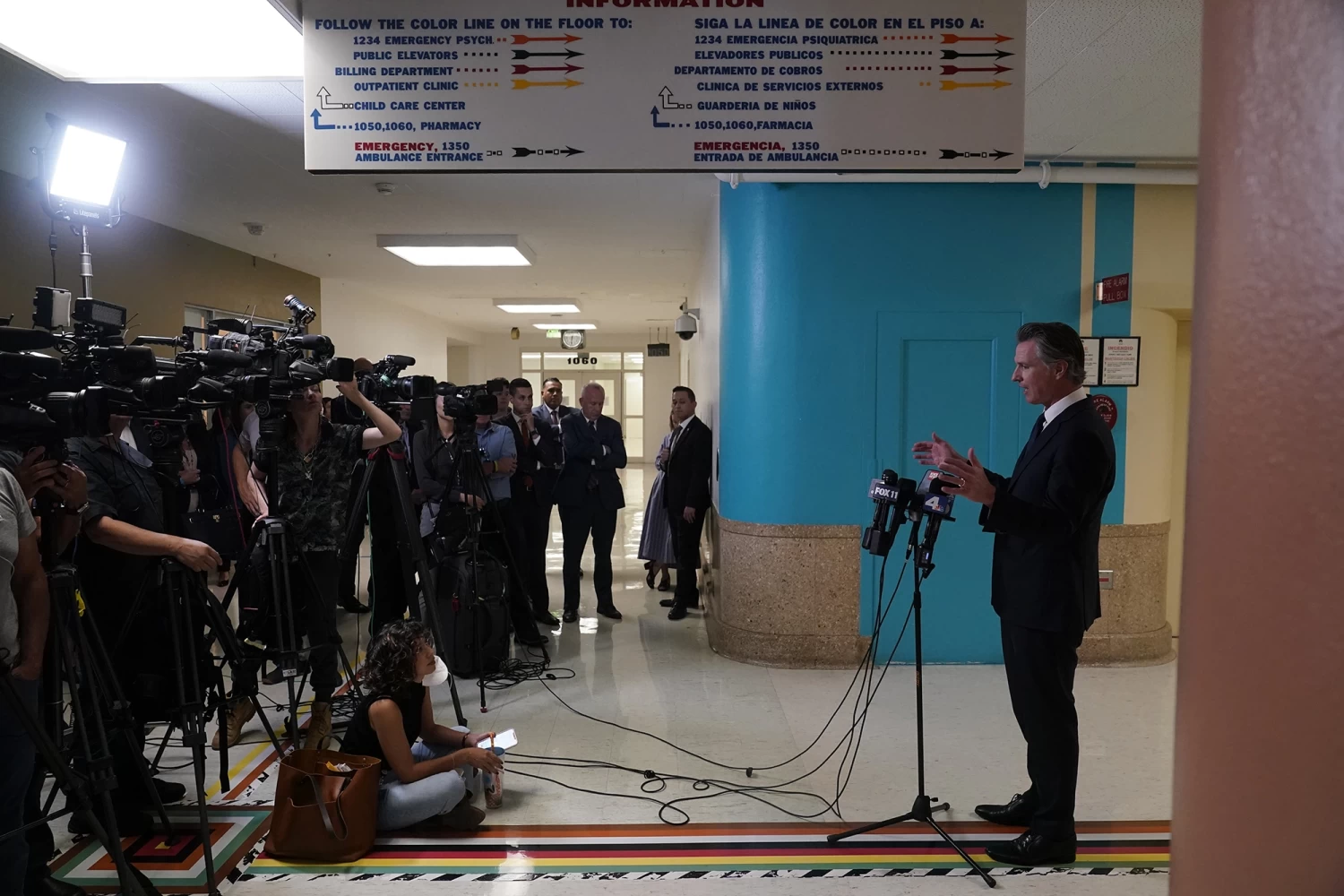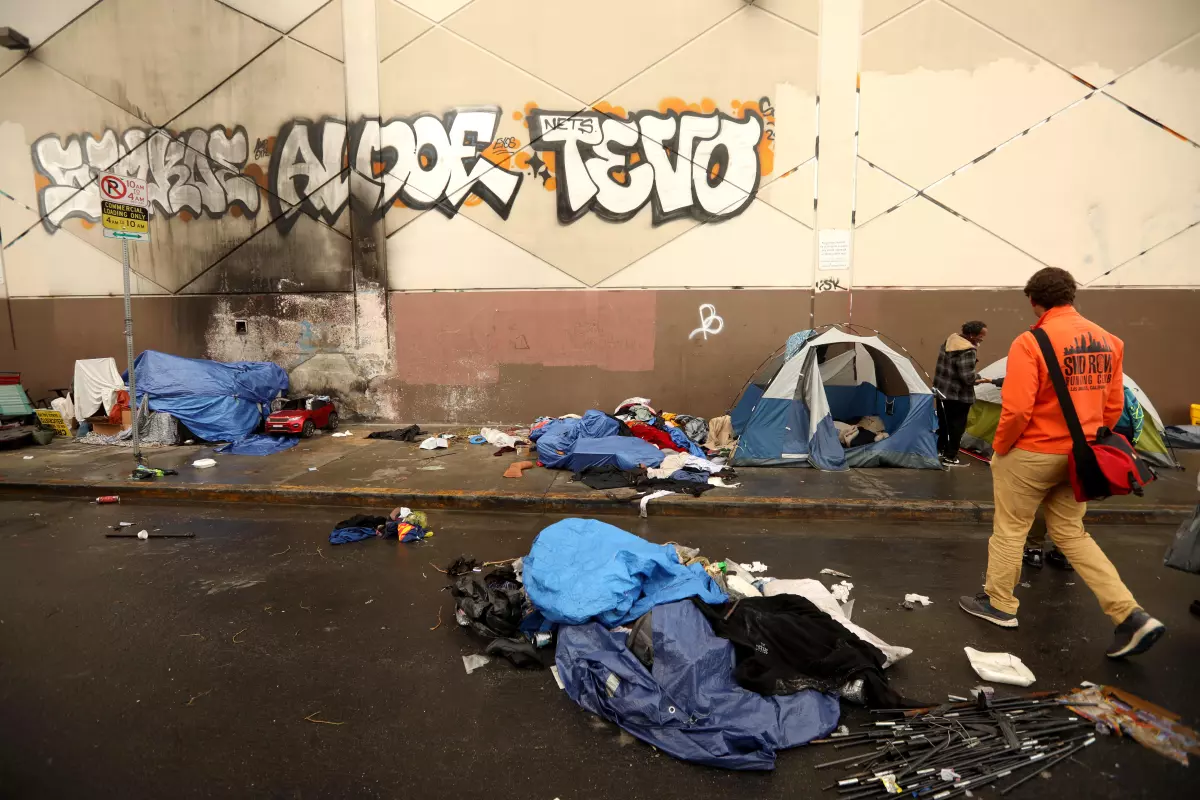This article is more than
1 year oldGavin Newsom is picking up where Ronald Reagan left off on mental health reform

|
SACRAMENTO, Calif. — Gov. Gavin Newsom is trying to finish the job Ronald Reagan started more than half a century ago as he seeks to transform California’s mental health system — even if it means forcing some people into treatment. In the last few months, the state established a court intervention program for people with severe mental illness and passed a law making it easier for relatives and first responders to send people to mandatory treatment. But the biggest potential development will be up to voters: In March, they’ll decide on a $6.4 billion bond proposal Newsom has pitched as part of his plan to build nearly 25,000 psychiatric and addiction beds statewide. Taken together, Newsom is billing the changes as a once-in-a-generation opportunity to finally set up the services and systems promised during the Reagan era to replace the giant mental hospitals of the bad old days, when thousands of people were thrown into institutions against their will. The ambitious Democrat is embracing the unlikely goal of building on a bedrock legacy of the conservative icon. |

|
But woven through the overhaul are new ways to compel people into care — and new facilities to house them. Civil rights and mental health advocates fear these changes, advanced amid mounting political pressure to curb homelessness, open drug use and untreated mental illness, will turn back the clock. “Are we risking institutionalizing people because we have nowhere else to put them?” said Rachel Bhagwat, a legislative advocate for the ACLU California Action, which has lobbied California lawmakers against expanding compelled care.A similar shift is playing out in Democratic strongholds throughout the country, from Seattle to New York City to Portland, Oregon, as leaders respond to a dramatic rise in homelessness that has made the lack of mental health services highly visible in recent years. But California — which has become the face of those problems with over 100,000 people living on the streets — is the first state where a Democratic governor has pushed such sweeping changes. Home to 12 percent of the country’s population, California accounts for half of the people living on the streets nationwide. Newsom’s plan reflects a striking tack to the center for California Democrats, who have taken harder lines on homeless encampments. Cities like San Diego have adopted policies including ticketing or arresting those who refuse to leave — a step that anyone on the left would have been loath to deploy just a few years ago. Hammering the left on homelessness, mental health and addiction is a perennial strategy of the state’s detractors on the right. Newsom, a former mayor of San Francisco, is constantly asked to answer for images of addiction and disease on the streets of the city’s downtown, and those questions will only get louder if — as widely anticipated — he runs for president in 2028. Newsom has framed his approach as a course correction decades after the country — starting when Reagan was governor in the 1960s and peaking in the 1980s during his presidency — emptied psychiatric facilities without ensuring the patients received the care or housing they needed. California alone warehoused 22,000 patients in the 1960s. |

|
“There was a righteousness in the ‘60s, with Democrats and Republicans saying, ‘We have to move away from these locked institutions,’” Newsom said this year before he signed a pair of mental health bills. “We were supposed to replicate that with community-based care and there was no accountability, there was no obligation either way.” The governor stresses that the bulk of the new services will be voluntary — and will provide shelter to thousands of people ailing on the streets. His bond proposal, combined with three other programs he’s rolled out recently, is expected to fund almost 46,000 outpatient treatment slots. Today, California has only a vague idea of how many people it can treat in outpatient settings — just that it’s not enough. That number could include slots in group therapy, detox, counseling or a host of other methods that don’t require a license and are hard to count. That’s part of the need for changes, officials say, to finally get a census of where the state is on treatment. It’s going to require a massive workforce to provide all the treatment the state is promising. Newsom’s proposal includes around $7 billion to beef up the workforce, which will rely on new medical education slots to supply practitioners, as well as people who have been trained as counselors after receiving substance abuse treatment themselves. “I know critics will say you don’t have the workforce so you can’t change the laws,” said state Sen. Susan Talamantes Eggman (D-Stockton), who wrote one of the laws that will appear on the March ballot. “For mental health care, we seem to think everything has to be existing in its perfect environment before we can make any kind of changes.”The fact that California is building new treatment facilities and training more staff on this scale is a feat unlike what other states are doing, California Health and Human Services Secretary Mark Ghaly said in an interview. The idea is to strengthen the entire spectrum of care, including with prevention and early interventions. “But it doesn’t obviate the need for some folks whose conditions become so severe, potentially so violent, so difficult to manage, that they do need some level of involuntary care,” Ghaly said. “The California vision for this is, is that [involuntary treatment] is only used when absolutely necessary.” Still, the bond measure allows some of the money for residential treatment to be used to build secure psychiatric facilities. California has also made it easier to put people into conservatorships, an arrangement that allows judges to appoint someone to make legal and health decisions for people they deem “gravely disabled” and unable to care for their health and safety. Compelled care, for some, will mean involuntary holds in a psychiatric facility ranging from 24 hours to evaluate a person to 180 days in extreme cases to treat them. Court-ordered treatment plans may include medication, therapy or a housing placement. Some mental health advocates fear Newsom is overcorrecting. “We’re looking at all of this, and it’s going in the wrong direction,” said Clare Cortright, policy director for Cal Voices, a coalition of groups that represents community mental health organizations. These groups and others have organized into Californians Against Proposition 1, to oppose the changes on the March ballot. With no professional organization or high-dollar backers, the opposition’s main asset is outrage from people in the mental health system who fear they’ll be funneled into involuntary treatment. The idea of forcing people into treatment had long been politically untenable for progressive Democrats, who saw it as a civil rights infringement. Until recently, few state lawmakers were willing to call for more conservatorships or court-mandated services outside the justice system — and California’s recent laws reflect a painstaking attempt at balancing such measures with civil rights concerns. But Democratic mayors of cities in the grips of housing and addiction problems have started loosening or changing laws around civil commitments, in which people living on the street who are unable to care for themselves are given court-ordered treatment plans. Some argue governments need a way to reach people who can’t or won’t seek help on their own. |

|
ew Jersey Gov. Phil Murphy signed a law this year doubling the length of time people can be held in hospitals against their wills. In Seattle, City Councilmember Sara Nelson is considering expanding the city’s involuntary commitment laws for people with untreated mental health or substance abuse disorders. And San Francisco Mayor London Breed has pitched a proposal to tie local welfare grants to treatment. Sacramento Mayor Darrell Steinberg, the architect of the nearly 20-year-old mental health law Newsom wants to change, has emerged as a prominent champion of the changes Newsom has proposed — often speaking on behalf of other big-city mayors on the frontlines of California’s homelessness crisis. Los Angeles Mayor Karen Bass has also been a vocal proponent, particularly for California’s new statewide civil court for people with schizophrenia and other psychotic disorders, a Newsom initiative that has begun to operate in a number of counties and will soon launch in Los Angeles. That program, called CARE Courts, may include compelled treatment. Civil rights groups have sued to block the program and the case is ongoing. 
“It is profoundly inhumane to allow people to suffer mental illness and die on our streets,” Bass said early this year, shortly after taking office. Over 80 percent of homeless people in the state report they’ve experienced a serious mental health condition, and two-thirds have struggled with alcohol or drugs. The fentanyl epidemic has created a spike in overdose deaths, with nearly 6,000 dying from fentanyl overdoses alone in California in 2021. Newsom often invokes the year 1967, when Reagan, then governor, started emptying the state’s large mental institutions in favor of less restrictive care. Most of the money saved by closing hospitals was supposed to go to community treatment. But creating a new treatment system didn’t prove as politically popular as dismantling the old one. “There was a guy named Ronald Reagan in 1967 — the year of my birth — with good intention and a bipartisan piece of legislation,” Newsom said when he announced his most recent proposal. “But here we have the opportunity to reimagine and to advance that original vision.” |
Keywords
Newer articles




